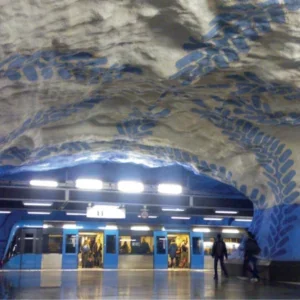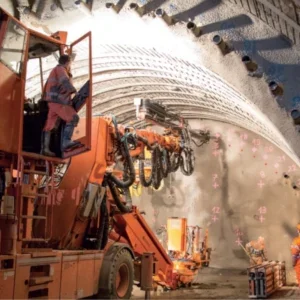The geology of Belfast consists mainly of Sherwood sandstone, a weak cemented sandstone, which extends across Northern Ireland and the north of England. The sandstone has been eroded by glaciations and is overlaid by glacial deposits of sands, gravels, clays and in the upper layer the notorious Belfast sleech, a marine silt, which is highly plastic and extremely weak. One peculiar feature of the Sherwood sandstone in Belfast is that it has been intruded vertically with quartz dolerite in the form of dykes, and where you encounter the bedrock, you would specifically encounter a dyke at 120m centres.
A great deal of work was undertaken with the site investigation with 59 new boreholes, a dozen cone penetration tests (CPT) and geophysical surveys to locate the dykes.
The tender required a geotechnical interpretive report with ground reference conditions and BenaimAssociates were engaged to produce this for the JV as they were well known as experts in the Belfast geology. TheMorgan Est – Farrens JV therefore believed they had a very robust approach to ground risk, with extensive sight investigation, an Engineering and Construction Contract 2 option Pain/Gain Contract and ground reference conditions as a benchmark. However, the author says he was taken by surprise with the tremendous variety and unreliability of the geology. The sight investigation, extensive as it was, failed to identify the significant amount of boulders in the upper Boulder Clay.
The geology determined the working method with the shafts sunk as jacked caissons in conjunction with dewatering, so the JV could sink dry whenever possible. They were completed in any depth of rock with underpinning.
Shafts
There were two serious heritage structures in the middle of Belfast adjacent to shaft 10; the Seaman’s Mission and the Port Authority Building. At this point of the contract, the JV was experiencing some difficulty with deformation on the cutting edges of the caisson ring, and so the method was changed from caisson to underpinning prematurely. There was no understanding what was wrong with the cutting edges, as they had been designedand used for long periods of time, but in the end they were changed from bolted connections to fully prepared welded connections. This cured the problem.
As shaft 10 had to be sunk, the JV was concerned with creating a problem with the heritage structures, so one wrapped caisson was constructed consisting of a segmental caisson surrounded by 300mm of in situ reinforced concrete producing a much stiffer structure. The caisson was sunk down 34m with a circularity of plus or minus 20mm. The JV debated the wrapped caisson after the project completion and agreed that in hindsight, a thicker section of shaft required a much more substantial cutting edge, and they thought the cutting edge was much more defining in the circularity than the wrap. However, the wrap did offer advantages at that location.
The tunnels were bored using a soft ground adapted EPBM supplied by Lovat; a machine that produced a predictable surface impact, which was essential in the built up urban environment of Belfast. This machine had mixed face capability and worked well in the variety of ground and mixed soil conditions.
In addition, the tooling on this machine was flexible, with scraper teeth used for the clay conditions and ripper teeth for the sandstone. Quantity of dolerite dykes was unknown at the time, with the sight investigation only picking up one, which was highly fractured. The individual pieces of dolerite when tested, achieved between 90 and 150 MPa, proving to be a robust material.
However, the JV was convinced that ripper teeth or disc cutters would work sufficiently, but as a last event, blasting was retained as an option. Drilling and blasting would be through the flood doors in discrete elements, then rotating the cutter head and drilling and blasting again.
The machine was originally being launched from shaft 10 but the JV had serious problems sinking this shaft to its full depth, so to preserve the program the TBM was launched from shaft 11. Shaft 11 was a 10m shaft, which meant ending up with a sectional launch with a short front shunt, driving forward with umbilicals and gantries placed on surface.
Shaft 11 was in the heart of the docks with no neighbours, so the equipment that was brought in for the whole project was used. These included two cranes, hoisting skips, with the rings placed on their backs directly onto the segment bogies. This was a relatively simply system, which achieved approximately 23ma shift in the alluviumand half this figure through the sandstone section.
The tunnels
The 4m tunnel was bored between the pile caps of the Cross Harbour Bridge. The most difficult part was in the city centre, where there was potential for dolerite dykes and sandstone in a tunnel invert, with a mixed face and running sand above axis. Scraper teeth were initially used in the clay section as the JV was not expecting to encounter any boulders.
However, shortly after launch boulders were encountered, which actually broke the screw resulting in grizzlies being fitted. This configuration was used for boring through the sandstone and eventually through the dykes. There was a couple of short drives on the 2.4m drive with the most interesting drive, according to Ronicle, through section seven to one, a 2.6km section, crossing the Dublin Belfast Railway Line and then under the urban West Link Express Way, which was crossed a second time further up.
The works were 24/7 in this location with the shaft top and the essential working area in this section covered with an acoustic shed, which gave 14 dBa attenuation. The shed was 34m long, 19m wide and 8m under the crane beam.
The work was much more mechanised in the 2.4m diameter section using a high altitude conveyor for the muck removal. In the pit bottom, the rings went down into a tippler, which placed them onto the segment cars. The mucking equipment was side tippers, dumping into a hopper underneath the pit bottom, then to a chain conveyor to the high altitude conveyor, eventually up the High Angle Conveyor (HAC) into the stacker.The HAC proved a great success on this project coping with sandy soup, gravel, clay, sandstone and blocks of dolerite.
The 2.4m machine went through an interesting development throughout the course of the project. The machine originally arrived at site with a soft ground head from the previous project and the JV achieved an average of 2.6m a shift on the first drive of a couple of hundred metres. Due to the painfully slow progress, it was decided to make serious modifications to the machine. Having completed that first drive it eventually went into contaminated sandstone achieving 8m a shift during this time, which gave the JV a period of Grace to work with the original head.
The modifications made to the machine were mainly in the soil conditioning and the way the material came out of the cutter head. The soil conditioning agent holding tank was inadequate, with a single pump feeding multiple ports at the front of the machine. This gave little control to where the conditioning agent went, along with zero feed back to the operator. Three foam pumps were eventually fitted, each dedicated to each port along with a much larger holding tank.
A dedicated polymer pump was also fitted to feed polymer into the screw conveyor, with feedback on flow rates and percentages to the operator. Due to the sticky nature of the older Clay, a stationary muck knife was also installed, which peeled off the clay as the drum rotated dropping the clay into the muck ring for removal.
The new improved head was launched from shaft 7, limiting the opening so the operator could peel the clay off in a controlled manner.
The machine achieved approximately 100mm a minute penetration, which would have produced the required 20m plus in a shift. However, the JV’s euphoria was short lived, as before it had even buried the shield, the drive ran into substantial quantities of boulders, which choked the Archimedian screw.
The JV was forced to put compressed air on the face, pull the screw out, clean it out and then modify the machine to a universal head. The team limited the openings at the excavation head right down to approximately 90mm to lessen the amount of stone, which could have entered the screw and broken it.
The head was also fitted with very large saddle teeth with tungsten carbide inserts, which broke everything it came across. However, this came at a price as only 17m a shift was achieved through the alluvium and 10m through the sandstone. The saddle teeth were worn but intact at the end of the drive but the gauge teeth were completely obliterated.
Contaminated ground
The middle of the job tunnelled under the old gas works site, and at the time of tender there was one borehole that showed very limited amount of hydrocarbon contamination. Additional boreholes were sunk once on site finding toluene, xylene and benzene contamination in the ground water. Because Benzene is a carcinogen, the water from the dewatering wells had to be treated after discharge. The water went through an oil and grit intersection and then through large activated-carbon filters. The shafts were then sunk in the dry and although there was no measurable concentration of benzene, there was a significant odour from the coal tar.
As a precaution, the crew were equipped with exposure suits, which offered ten times occupational exposure limit (OEL) protection from benzene.
The contamination was above tunnel horizon and the JV perceived that once it turned off the dewatering prior to tunnelling, the water table would recover and light fraction hydrocarbons would float on the top cancelling out any issues.
As a precaution, the JV took advice from the UK Health and Safety Executive (HSE) and Employment Medical Advisory Service (EMAS) and prepared for contamination just in case they hit it. In the end they hit substantial concentrations of contamination during the drive and subsequently fitted out the crew with exposure suits able to withstand 40 times OEL protection. Everytime the crew came out of the shaft they went through a contamination procedure, which involved showering down to clean the suit off and discarding the chemical over-suit and their gloves into a chemical waste skip.
Industrial work wear was also laundered on site to avoid contamination.
Under pressure
Compressed air was used several times on the project, once for damage to the articulation in the 4m-diameter machine and once to a damaged screw in the 2.4m-diameter machine. It was also used in shaft breakouts, which was not anticipated at the time of tender due to the unreliability of the ground.
The JV only ever expected to do interventions, so they had a fairly simple setup with a boiler lock and oxygen bibs for decompression. The JV operated to Northern Ireland regulations. The current standard is the Black pool Tables for oxygen and re-breathing, the JV was not keen on using these partly because if you typically work four to six hours at two bar, in the last stage of decompression you have to breath oxygen through a bib for forty minutes at only 0.2 bar over atmospheric pressure. This would have proved very uncomfortable.
The JV’s advice was to use the German dedicated oxygen tables now called the Swanscombe Tables, following their successful use on the Channel Tunnel Rail Link Project. The JV approached the HSE and gained approval to use the Swanscombe Tables although the HSE asked the JV to undertake original medical research to monitor the evolution of bubbles in the blood stream during the decompression process. This was undertaken through 75 high pressure exposures through Doppler monitoring.
The only other change in Belfast was the switch to using MRI scanning instead of the traditional long bone x-rays used as a diagnostic method for bone necrosis in people who have been exposed to high pressures. EMAS in Northern Ireland were keen to minimise the exposure to x-ray radiation wherever possible. EMAS approached a consultant radiologist and eventually the Institute of Radiologist and convinced the JV that MRI scanning was a valid tool for bone necrosis. There was a big cost difference, with long bone x-rays at £150 (US$243) a set and £2000 (US$3237) for a scan.
The 2.4m clay cutter head Pipe jacking Jacked caissons and dewatering allowed the JV to sink dry Contamination suits extended the allowed working hours Boulders broke the TBM’s Archimedian screw






